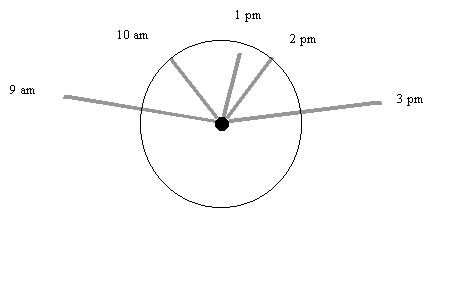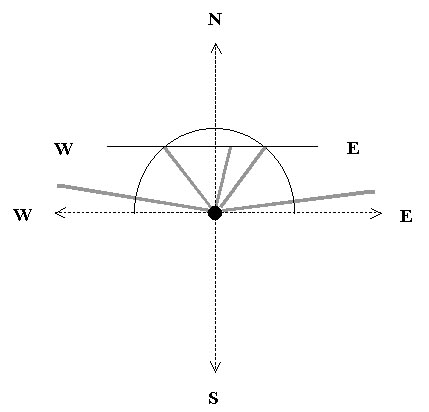
Middle School Astronomy Activity
Written by Judy Young, Melissa Goldman, and Bill Randolph
Lesson l: USING SHADOWS TO FIND THE FOUR DIRECTIONS
A. Reference to Standards:
National Science Education Standards
, Grades 5-8 (NRC, 1996)Science and Inquiry Standards
:-Answer questions that can be solved by scientific investigations.
-Design and conduct scientific investigations.
-Use appropriate tools and techniques to gather, analyze and interpret data.
-Think critically and logically to make relationships between evidence and explanations.
Earth Science Standards:
-Compare and contrast properties and conditions of objects in the solar system to those on Earth.
-Explain how the tilt of the Earth and its revolution around the Sun results in uneven heating of the Earth, which in turn causes the seasons. Those motions explain such phenomena as the day, the year, phases of the moon and eclipses.
-Seasons result from variations in the amount of the sun's energy hitting the surface, due to the tilt of the earth's rotation on it axis and the length of the day.
Reference to the Massachusetts State Science Standards, Grades 6-8 (11/00)
Earth Science Standards:
-Compare and contrast properties and conditions of objects in the solar system to those on Earth.
-Explain how the tilt of the Earth and its revolution around the Sun results in uneven heating of the Earth, which in turn causes the seasons.
B. Learning objectives:
-Identify the North, South, East and West directions using the
shadow from a gnomon.
-Collect shadow data in a systematic manner.
-Note and describe how shadows change throughout the day and how noontime shadow lengths
C. Materials:
Gnomon (pencil, tinker toy, etc)
Compass
Ruler
Large protractor
Pencil or chalk
Large piece of paper
Time Required: At least one full-day to collect data and one or two additional days to process, and interpret the results.
D. Background:
This lesson tries to address many common misunderstandings and misconceptions that students have about the Earth's orbit around the Sun. In this lesson, students can gather enough empirical data using the Sun's shadow to: establish the four directions, track the daily rotation of the Earth around the Sun, prove that the Sun is never "straight up" or directly overhead at our latitude of 42 degrees, and understand that the Sun does not necessarily reach its highest point in the sky at 12:00 noon. Additionally, students will gain knowledge of the four directions, which is essential for students to be able to accurately describe objects related to astronomy, navigation, map reading and orienteering.
Once the directions are established, an additional avenue of inquiry involves measuring shadow lengths when the Sun is due south (around noon). These shadow lengths will change regularly throughout the year, and the goals of this activity are described in Lesson III. If Lesson III is repeated throughout the year, then students can graph data that proves the Earth's axis is tilted at 23 ? degrees.
You might begin this lesson by asking some pre-assessment questions. For example:
The more time students are allowed to develop there own ideas into actual experiments and collect and analyze data, the more you will learn about their current knowledge in the topic as well as some important insights into their misconceptions.
E. Procedures:
The Set-Up: A Gnomon Within a Circle
In this lesson students will use the shadow cast by a gnomon to identify the four directions. A gnomon is a freestanding, vertical object, which casts a shadow on the ground. Some examples of gnomons include a pencil stuck into the ground, tinker toys, tetherball pole, or even an golf tee glued upside down onto a piece paper. The type of gnomon is not as important as having a flat surface from which you can draw or trace the length of the shadow as it changes throughout the day and having the gnomon be absolutely perpendicular to the flat surface. Never move a gnomon once you begin an experiment. If a gnomon is glued onto paper, then anchor the paper down with tape or rocks. It is also important to choose a location with full Sun throughout the day. Be careful not to use an area that gets shade in the afternoon. A classroom with south-facing exposures can work during certain times of years, but they may not work year-round if you plan on repeating the experiment.
The gnomon should be placed in the center of a circle with a radius specified in column 4 of the following table. Ideally, the morning shadow should extend beyond the outside of the circle, the noontime shadow should be within the circle, and the shadow should lie exactly on the circle about 10a.m. and 2-3 p.m. If the morning shadow is within the circle, then the circle is either too large or the gnomon is too small. Let the students hypothesize how big they think their circle needs to be in order for the longest shadow to extend beyond the edge. You might be surprised to see how few students can actually predict how an object's shadow will change in a day or throughout the year. Depending upon your time restraints and space available, you can either let students create their own gnomon and then determine the appropriate size circle or you can photocopy a circle on paper and have everyone use the same size gnomon, such a golf tee glued upside down. Always make sure the gnomon is located exactly in the center of the circle.
2.) Recording Data: Measuring the Gnomon's Shadow Lengths
If you are teaching several classes in the same day, then each class can take measurements during their class period. The measurements themselves only take a few minutes. You could try assigning this activity as weekend homework project if you wanted students to collect their own data throughout the day.
In order to find the four directions, the students will have to trace oxver the entire shadow roughly every hour. The students can record the time of day next to each drawing. In the morning when the Sun is low on the horizon the shadow extends westward beyond the outside of the circle. In an hour or so, as the Sun appears to move higher in the sky the shadow's length shortens. The first important data point is when the shadow falls exactly on the edge of the circle. In another hour or two, as the Sun is due south and is highest above the horizon, the shadow will reach its smallest size. In the afternoon, the shadows will begin to lengthen again and fall eastward. The second important data point is when the shadow once again lands precisely on the circle. At the end of the afternoon, the students should have a recording sheet that looks like Figure l.
Figure 1. Student Recording Sheet.
Example of how shadows will appear in February or October

Teacher Note:
At noontime, you can have the students estimate how high the Sun is above the horizon, where zero is the horizon and 90 degrees is overhead. Again, many students assume the Sun is directly over their head at noon. You might discuss later that the Sun is never overhead at this latitude (42 degrees). One has to stand on the Tropic of Cancer at latitude 23 1/2 degrees on the summer solstice in order for the Sun to be at zenith or overhead at noon.
Data Analysis: Establishing the Four Directions
3a. Ask the students to make X's at the ends of these shadows that landed on the circle.
3b. Connect the X's using a meter stick or ruler as shown in Figure 2. The line connecting these two points identifies the East-West directions.
3c. Indicate the East end and West end of this line. (East being the direction to the morning Sun when the shadows pointed westward).
3d. Ask the students to find the midpoint of the East-West line.
3e. At the midpoint of the East-West line, create a perpendicular line (which also goes through the gnomon and the center of the circle).
3f. The students should mark this line with the North and South directions. (All noon-time shadows will appear on the North side of the gnomon).
Figure Two: Calculating the East-West direction.

Table 1: Shadows to Expect for a 12" Gnomon
Noontime Angle
Month to the Sun(Amherst ) Noontime Shadow Optimal Radius
|
December 21 |
24 ? degrees |
26.3 " |
32" |
|
Jan, Nov. 21 |
24 ? degrees |
22.6" |
30" |
|
Feb, Oct. 21 |
36 degrees |
16.5" |
24" |
|
March, Sept. 21 |
48 degrees |
10.8" |
16" |
|
April, August 21 |
59 degrees |
7.2" |
10" |
|
May, July 21 |
68 degrees |
4.8" |
7" |
|
June 21 |
71 ? degrees |
4.0" |
7" |
Extensions:
Allow your students to compare the four directions they determined with those shown by a magnetic compass. This discrepancy can lead students towards investigating true or astronomical north versus magnetic north in their particular geographic area.
Things to remember for this activity to be successful:
Direct Sunlight is essential
Choose a site with direct sunlight for most of the day. Is important that the gnomon be in direct sunlight in order to get accurate data. This is not always possible indoors. This may work in a south-facing window --but there may not be enough light in the winter if you want to repeat the experiment.
The gnomons and shadow records must be stationary all day long
The gnomon and shadow recording sheet should be in the same place for every measurement. These objects should be secured to the ground or made immovable -- and left where they will not be disturbed. Some teachers may choose a large fixed gnomon outdoors like a pole, post, etc. Data can be recorded in chalk on the sidewalk, with shadow measurements and times written down on the data sheet.
The activity is flexible for an individual, group or whole-class exercise
This is a matter of personal preference and should be based on the teaching and learning styles of both the teacher and the students. This choice may also be based on the duration of the activity. If you plan to continue recording shadows throughout the year -- it might be best to have just one permanent gnomon for the whole class. While it might be good for the students to have their own at first. If you teach multiple classes in a day and you feel it important for students to see the continuous motions of the Sun's shadow, then try assigning the activity as homework.